Updated: 05-Dec-2018
G.E. (Part 2)
(USA)
Continued from part 1
-También traemos a colación ahora unas más detalladas instalaciones fijas de pruebas de los motores turborreactores con energía atómica de ésta misma General Electric, en las instalaciones de Idaho Falls.
Now, we also bring up more detailed information of fixed turbojet engine tests with atomic energy, developed by General Electric at the Idaho Falls facilities.
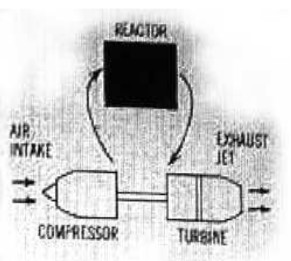
"Outline of the atomic reactor idea"
-Practically, the engine is the same. The main difference is that the classic combustion chambers have been replaced by some ducts that lead to the body (core) of the atomic reactor where the air is heated as well, and returned to the intake of the turbine.
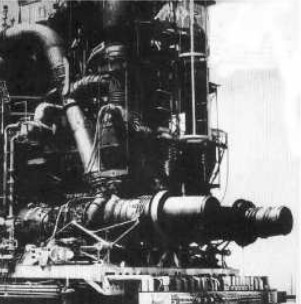
“Atomic turbine test site”
-See main text to view other tested variants.
-And now, a new discovery of GE's I-A, turbojet engine, built in small quantity and exposed, whole but without accessories at the Combat Air Museum in Topeka, Kansas.

“GE-Whittle I-A model”
-General Electric did several projects of nuclear engines. In the main text we have seen the use of J-47 and J-79 turbojets.
-Now we have discovered another group of nuclear plant that was based on the J-57 turbines. This was project X-39 and X-40.
-The were planned to be installed on the Convair B-36, with a protection for the crew that gave way to the X-6, first with J-53-GE-1 engines. It did not pass the project stage.
-The P-1 power plant was composed of four turbojet engines and a R-1 nuclear reactor.
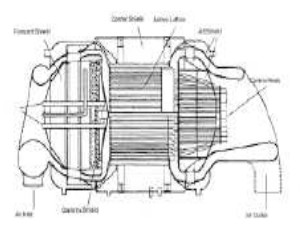
“R-1 reactor”
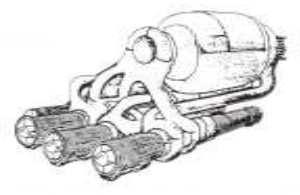
“Complete R1+P1 group”
-The air that comes out of the compressors goes through the reactor and returns to the turbine intakes, ignoring the classic turbojet combustors.

“XP-81”
-With regard to the information in the main text, about the TG-100 that flew in the XP-81, a better scheme of the airplane is now available and its internal proposal comes into view. This engine was in the nose, and in the tail it had a I-40 (J-33).
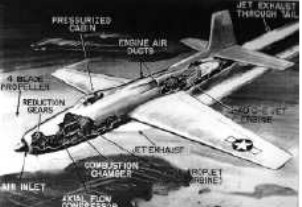
“Factory drawing of the XP-81”
-In the main text is missing the X-405 rocket engine that we have now achieved.

“General Electric X-405”
-We have been remitted a General Electric rocket engine from the years 1950-1952. It has a classic aspect for that time. It was the X-405.
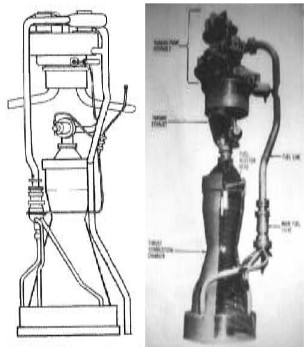
"GE Engine of the Vanguard Project"
-A drawing and a photography of a cutaway.
-General Electric is a builder of important aviation turbines. But of the first ones, perhaps the most significant was the J-47 for the NA F-86 "Sabre".
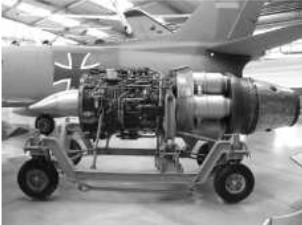
“GE J-47, already at a museum”

“The author and his wife next to a Sabre”
-Las FFAA españolas recibieron unos 300 F-86. El no 1 estuvo en la Escuela de Mecánicos de León, donde el autor se formó. En el año 2011 se cumplen 50 años del ingreso del autor en esa Escuela. Fue un feliz reencuentro en el acto oficial conmemorativo. Ver foto.
The Spanish Armed Forces received about 300 F-86 aircraft. The number 1 was at the School of Mechanics in León, where the author was formed. In 2011, it was 50 years ago that the author started to study at that School. It was a happy reunion at the official memorial ceremony.
-In the teachings I received, we were told about the classic defects of the first turbine engines with axial compressor and separate chambers, such as "compressor losses", "hot spots in chambers" or "leaving blades".

“The Sabre teeth”
-It was the main allied plane in the Korean War. His opponent was the MiG-15, of different concept: First the engine of this one was centrifugal compressor (see VK-1,), and the lighter and more maneuverable airplane.
-The missions were also different: while the MiG-15 was an interceptor with cannons to shoot down the B-29, the Sabre sent a cloud of bullets to hunt down his opponent.
-If in an atypical maneuver or with slip, the air entered the intake making a whirlwind and struck the blades with negative angle, the compressor lost its efficiency -loss of compressor- and the combustion vomited forward with blows. The solution was to straighten the maneuver, taking back the power control and once stabilized, smoothly accelerate again.
From Appendix 9: Now we have info on some rocket engines recently arrived at our archive.
-Hermes A-1
-Hermes A-3A
-Hermes A-3B
-LR-50-GE-1
-X-405
-X-430
-From the experience in civil and military turbines follows the construction of new industrial facilities such as the following two recently appeared in the General Electric.
-The first one that we show is the LM-6000 PCe (in the line of the LM-2500), working with new fuels such as those derived from sugarcane ethanol, when in the previous models they worked with diesel fuel number 2.
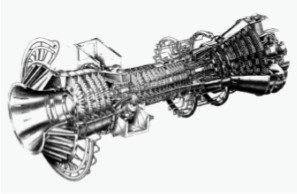
“LM-6000 PCe cutaway”
-The other industrial turbine is the G-9E BFG (initial Blast Furnace Gas) to blow the gas and coke coal furnaces while generating electricity.
-To be used in Steel Plants (Blast Furnaces).
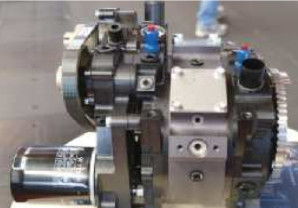
“Industrial GE-9E engine”
-It is hard to see what components of the aeronautical GE-9 are used in this engine.
-What is clear, is that the combustion chambers are not: individual and separate. And the flow is inverted.
-Una nueva turbina Turbofan de tamaño medio y para los aviones canadienses Bombardier, del modelo Global 7000/8000. Es el motor “Passport” de 18200 lbs de empuje al despegue.
There is a new Turbofan of medium size destined for the Canadian Bombardier aircraft, the Global 7000/8000 model. It is the "Passport" engine with 18,200 lbs of thrust at takeoff.
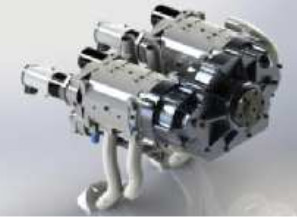
“GE Passport model engine”
-The LMS-100 is a GE industrial turbine that is also based on aviation. It is built in collaboration with GKN, who is specialized in this type of engines and applications.
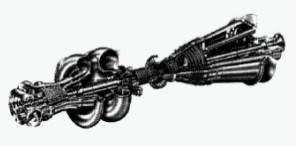
"GE LMS-100”
-General Electric, competing with P & W, enters the program of the USAF Research Laboratory, for the ADVENT (AETD).
-An installation concept in which the turbine-compressor-combination ratios are taken care of for greater efficiency.
-ADVENT stands for ADaptive Versatile ENgine Technology.
-General Electric was very active in nuclear aircraft propulsion.
-To those described in the main text, "Desclassified" information with new data continues to appear.
-The XMA-1 project used two X-211 engines. However, the proposed nuclear project in 1960 used a single X-211 engine, modified to XNJ140E.

“GE, XNJ140E”
-They came to test in 1962. It would give way to XNJ140E-1. It could work as a normal reactor weighing a total of 18,320 lbs. However, the nuclear device that included the reactor, the controls and above all the armoring increased the weight with another 42,230 lbs, and the total exceeded 60,000 lbs, which is huge for an airplane.
-The nuclear reactor was not very large because it was installed inside the turbojet. It was about 33 inches long by 62 in diameter.
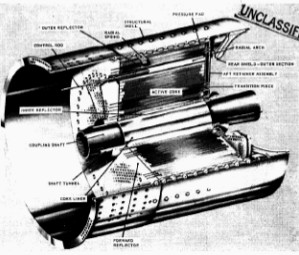
“Reactor for the XNJ140E-1”
-The honeycomb of the body was composed of about 25,000 hexagonal tubes of material that was very resistant to heat (reached more than 2500 °F). The engine delivered 35,300 lbf of thrust.
-At the USAF museum in Dayton, Ohio, there is an engine on a pulley that looks like a GE J-35 or even J-47 model engine, but it is marked ET-31-1. It has even an S/N. See the below photographs sent by a collaborator (MMC).


“ET31-1 engine”
-Amazing is the volume of the frontal cone that involves the starter, pumps, generator, etc. It is clear that it does not carry the accessory box in the lower part to accommodate these devices.
From Appendix 10: The first developments from the V-2 engines brought from Germany and evolved for the American Hermes missiles (also from the V-2) is due to this brand.
-The GE-405 was a rocket engine that used LOX and kerosene and was used in the upper stage of the Vanguard. As a curiosity the gases of the turbo-pump were used for the "Roll" control.

“The GE-405 for the Vanguard, 2nd stage”
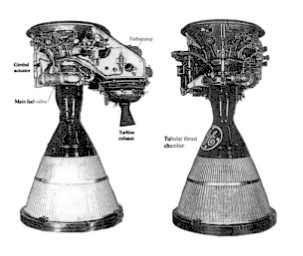
“Two GE-405H views for the Vega, 2nd stage”
-The Vega rocket engine (Atlas-Vega) used LOX-R.
-The GE-412A was planned for the NAA X-15 experimental supersonic aircraft. It was the possible substitute before the first difficulties of setting up the XLR-99.
-General Electric made a prototype of the Spike engine as a demonstrator and for tests. It gave 16K lbf.

“GE Aerospike needle or cone type”
-Towards 2014, a GE catalog mentions the GE-3000 turboshaft engine that is used by the "Black Hawk" helicopter.
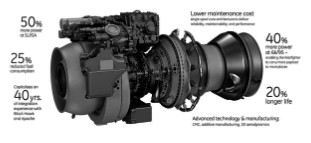
“GE-3000”
-This turbine is the successor of the T-700, very common until now.
-The industrial turbine/nav LM-6000 is developed jointly with MTU on the basis of the CF-6.

“GE/MTU, LM-6000”
-From General Electric, the last development from the GE9- is the GE9-X. It is intended for the Boeing B-777-X aircraft.
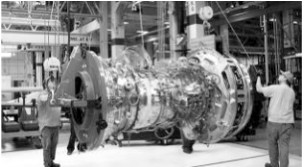
"Final assembly stage of the GE9-X"
-In the USA they present engines that are made in the old Walter, now in the hands of General Electric. It is the H80 series, a new range of turboprops for general aviation with powers between 700 and 2,000 shp.
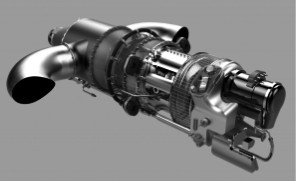
“GE's new turboprops (Walter)”
-Actually, they are the Walter M-600, improved and modified according to the General Electric criteria.
-They have inverted flow, like the PWC PT-6, (although it is not well known who influenced who).
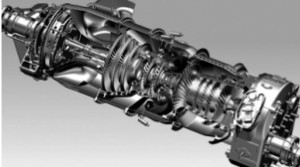
“GE new turboprop cutaway”
From Appendix 12: General Electric has extensive experience in aviation gas turbines. But also in Marina and in Industrial facilities.

“GE LM-2500”
-One of the engines mentioned in the main text is the LM-2500. Now we can show a good color photo. The older brother would be the LM-6000.
-New views of the turboprop engine up to 1,300 HP. This time it is destined for the Cessna "Denali", similar to the Pilatuys PC-12 and Socata TB-700, in general.
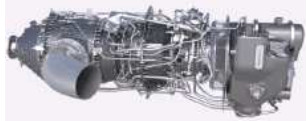

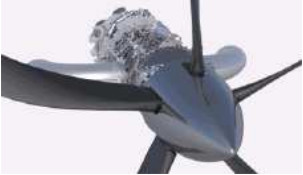
“General Electric turbohélice para el Denali”
-It seems that at the 2017 Paris Air Show important contracts of this engine have been signed.
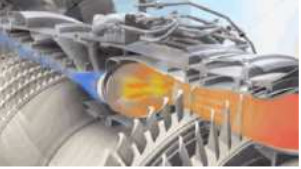
"GEnx gas flow design"
-GE has entered the construction with 3D printers for complicated parts. They do not need so much mechanization and can use metallic materials and composites.
-Precisely in the manufacture of components of the camera can reach 2,400 °F with this technique. What favors a better combustion and fuel saving.
-The same is used with the development of the new GE9x considered 4th generation, and that has the fan mix of composite and titanium.
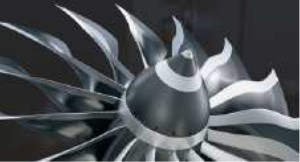
“Fan built with 3D technics”

“GE9x on test bench”
-This year 2017 is the explosion of construction with 3D printers. They are not using thermoplastic yarn, but different metals that are used in engines. An example can be the nozzle (fuel nozzle) for the LEAP engine.

"Manufactured with 3D printer procedures"
-Specifically this injector, which is made at GE by the Additive Manufacturing department, following ASTM F42 and ISO standards, is one piece, while the genuine injector consists of several pieces.
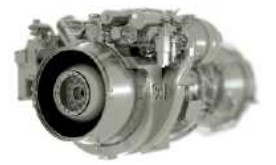
“GE T-901 with various parts made in 3D”
-The T-901 turboshaft that is used on the Apache and Black Hawk helicopters now have internal parts made with 3D technology.
-Finally, at the 2017 "Oshkosh" aeronautical contest , it was confirmed that the new turboprop has a significant amount of parts made by 3D printers with metallic additive.
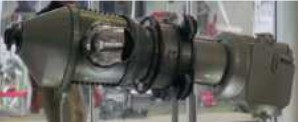
“A first Additive 3D version”
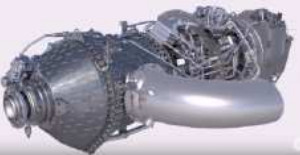

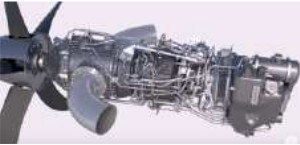
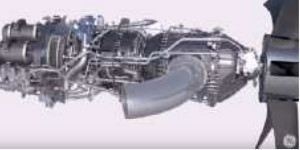

"Five photos of a more advanced turboprop model"
-Closely observing, we see that the gearbox has an external design with triangular ribs and rhomboids to reinforce the set.
From Appendix 13: The new GE "Passport" intended for the Bombardier Global 7000/800 and possible engine replacement for the old B-52H.
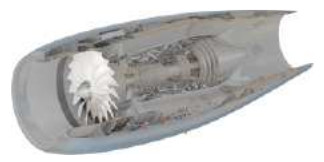
“GE Passport”


